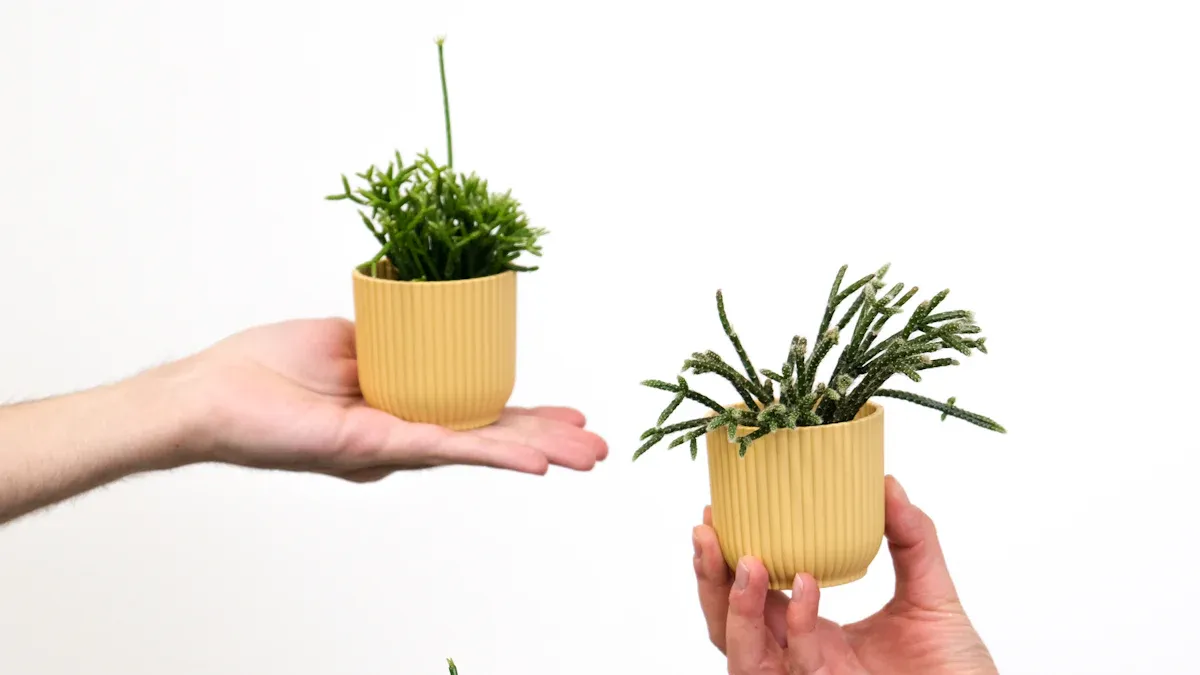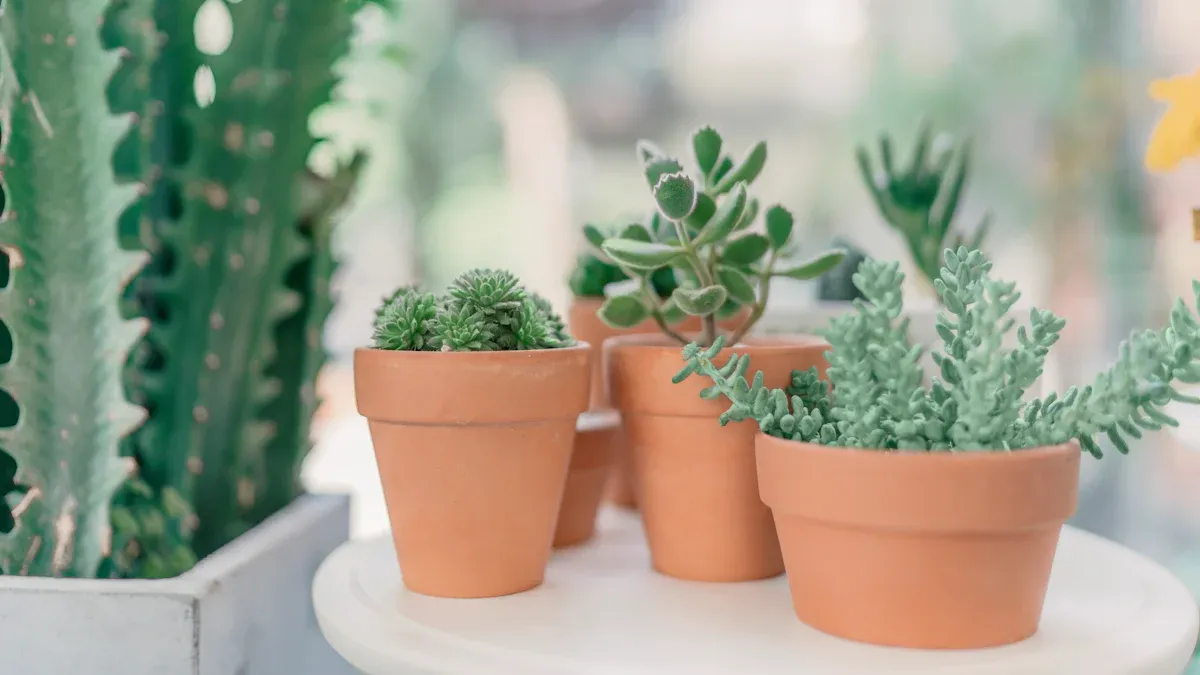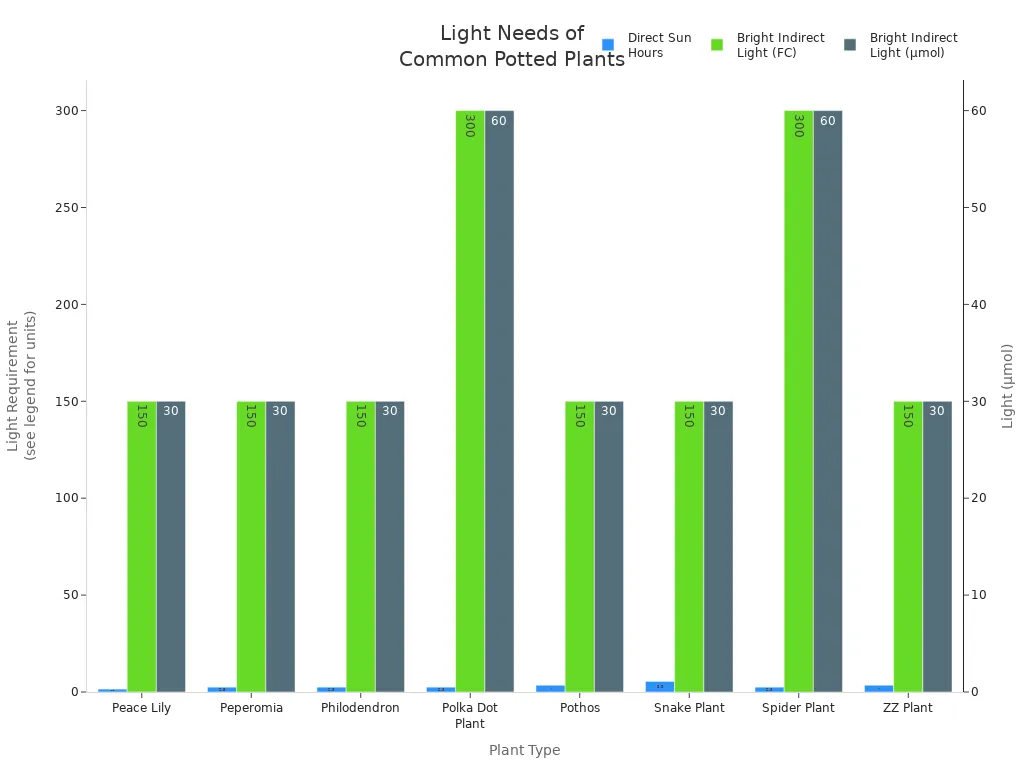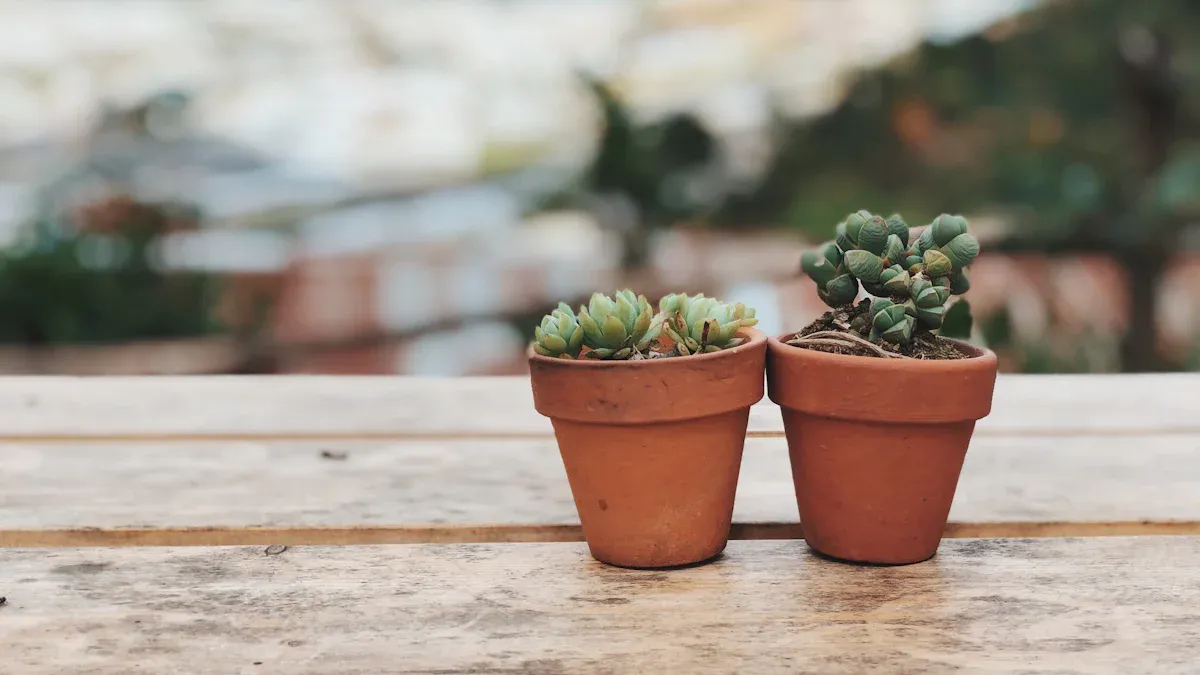
You can enjoy a thriving collection of small plants even in a small space. Many people choose succulents, African violets, or air plants for their beauty and easy care. Miniature hostas like ‘Blue Mouse Ears’ and popular options such as aloe vera or golden pothos also suit small pots well. About one-third of households now grow small potted plants, showing how much people enjoy these plants in limited spaces. Small plants fit perfectly on windowsills, desks, or shelves, letting you bring nature indoors without needing a big area.
Key Takeaways
Choose small plants that stay compact and grow slowly to fit well in small pots without stressing their roots.
Match your plant’s light and water needs to its location; small pots dry out faster and need more frequent watering.
Use well-draining soil and pots with drainage holes to keep roots healthy and prevent overwatering problems.
Repot plants every 12 to 18 months or when roots outgrow the pot to maintain strong growth and health.
Display small plants creatively using wall planters, hanging pots, or grouping to save space and add beauty indoors.
Choosing Small Plants
Size and Growth
When you pick small plants for your home, you need to think about how big they will get and how fast they grow. Some indoor plants stay small and grow slowly, which makes them perfect for small pots. If you choose a plant that grows too fast or gets too large, its roots will not have enough space. This can cause the plant to become stressed or stop growing well. Shallow-rooted plants like microgreens, mint, and strawberries do well in small pots because their roots do not need much room. You should always use a pot that is just a little bigger than the plant’s roots. This helps the plant grow without giving it too much soil, which can hold too much water.
Tip: Check the plant label or ask at the nursery about the mature size and growth rate before you buy.
Light and Water
You must match your plant’s light needs to the spot where you want to keep it. Some indoor plants, like cacti, need full sun, while others, such as African violets or cast iron plants, prefer bright, indirect light or even shade. If you put a sun-loving plant in a dark spot, it will not thrive. Watering is also important. Small pots dry out faster than large ones, so you will need to water your plants more often. Always check the soil before watering. If it feels dry, it is time to water.
Plant Type | Light Needs | Watering Needs |
|---|---|---|
Cacti | Full sun | Low, let soil dry out |
African Violet | Bright, indirect light | Keep soil moist |
Cast Iron Plant | Shade | Low, let soil dry out |
Air Plant | Bright, indirect light | Mist regularly |
Maintenance
Small indoor plants in small pots need a bit more attention than larger ones. Their roots fill the pot quickly, so you may need to water them more often. You should also watch for signs that the plant has outgrown its pot, like roots coming out of the drainage holes. Repotting helps keep your plant healthy. Regularly check for pests and trim dead leaves to keep your plants looking their best. Grouping plants with similar needs makes care easier and helps them thrive together.
Best Small Plants

Succulents & Cacti
Succulents and cacti are some of the best small plants for small pots. You can find many types that stay compact and thrive indoors. These plants store water in their leaves or stems, so they need less frequent watering. They also have shallow roots, which makes them perfect for small containers.
Tip: Use a well-draining soil mix with perlite, sand, and coconut coir. Always choose pots with drainage holes, and avoid overwatering.
Here are some popular compact varieties:
Plant Name | Botanical Name | Bloom Colors | Sun Requirements | Typical Height |
|---|---|---|---|---|
Opuntia microdasys | Creamy Yellow | Full Sun (Summer), Part Sun (Winter) | 2-3 feet | |
Star Cactus | Astrophytum asteria | Red, Orange, Yellow | Full Sun | 3 inches |
Thanksgiving Cactus | Schlumbergera truncata | Red, Purple, Orange, Pink, Creams | Part Sun, Light Shade | 12 inches |
Burro’s Tail | Sedum morganianum | Pink to Deep Red | Full Sun | 1-4 feet |
You should place succulents and cacti in a bright spot with at least 6 hours of sunlight. Water only when the top half-inch of soil feels dry. Terracotta pots help the soil dry out faster and keep roots healthy. Repotting is rarely needed, usually every five years.
Small Indoor Plants
Small indoor plants add greenery to your home and fit well on desks, shelves, or windowsills. Many of these plants grow well in low-light conditions and need little care. You can choose from a wide range of options.
Snake Plant: Grows in low light and needs little water.
Golden Pothos: Easy to care for and grows in hanging baskets.
Peace Lily: Blooms white flowers and helps clean the air.
ZZ Plant: Tolerates low light and stores water in its roots.
Ponytail Palm: Has a unique look and needs minimal watering.
Plant Name | Light Requirement | Mature Size | Watering Needs |
|---|---|---|---|
ZZ Plant | Partial to full shade | 3-4 ft tall | Allow soil to completely dry out |
Snake Plant | Partial shade | Up to 8 ft indoors | Allow soil to dry out between waterings |
Golden Pothos | Partial to full shade | Vines up to several feet | Allow top 2 inches of soil to dry |
Spider Plant | Partial shade | 12-15 in tall | Allow top 2 inches of soil to dry |
Peace Lily | Low light | N/A | Keep soil moist but not soggy |
You can use small indoor plants to brighten dark corners. These plants do not need much sunlight and can survive if you forget to water them sometimes. Studies show that both small and large indoor plants have a similar, but limited, effect on air quality. You would need many plants to see a big difference.
Herbs & Edibles
You can grow many herbs and edible plants in small pots indoors. These plants give you fresh flavors for cooking and are easy to care for. Most herbs need a sunny window and well-draining soil.
Chervil
Chives
Mint
Oregano
Parsley
Rosemary
Thyme
Lemon Balm
French Tarragon
Sage
Plant Type | Recommended Herbs and Edible Plants for Small Indoor Pots |
|---|---|
Herbs | Basil, Dill, Mint, Chives, Oregano, Cilantro, Parsley, Rosemary, Thyme, Lemon Balm, French Tarragon, Sage |
Vegetables | Dwarf/compact cultivars of Peppers and Tomatoes, Leafy Salad Greens, Radishes, Microgreens |
Microgreens are a great choice if you want a quick harvest. You can grow them in shallow trays and harvest them when they reach 1–2 inches tall. The yield depends on the type and growing conditions, but you can expect a good amount from a small tray. Always use separate pots for each herb to match their water and light needs.
Flowering Varieties
Flowering small potted plants bring color and beauty to your space. Many varieties bloom for months and do well in containers.
Marigold: Blooms from spring to fall, easy to grow, and repels pests.
Johnny-jump-up: Has a long bloom period and a delicate fragrance.
Pinks (Dianthus): Offers colorful and fragrant blooms from late spring to fall.
Creeping Zinnia: Drought-tolerant and blooms in summer and fall.
Lantana: Flowers from May to October and tolerates heat.
Geranium: Needs regular watering and blooms from May to October.
Pentas: Loves the sun and blooms in summer.
Many small flowering plants in containers bloom from spring until frost. Some, like Calibrachoa and Angelonia, do not need deadheading and keep blooming all summer. You can cut them back in midsummer to encourage more flowers.
Air Plants & Ferns
Air plants and ferns are unique choices for small pots. Air plants do not need soil and can grow in shells, glass globes, or small containers. They absorb moisture from the air and need only weekly soaking.
Species Name | Size (Height) | Key Features and Suitability for Beginners and Small Pots |
|---|---|---|
~2.5 x 3.5 inches | Small clumping rosette, thick leaves, partial shade tolerant, good for small containers | |
Tillandsia ionantha ‘Rubra’ | ~2 inches | Small size, fuzzy foliage, bright red/orange in sun, ideal for terrariums or seashells |
Tillandsia aeranthos (Flower of the Air) | 6-9 inches | Dark green foliage, pink/blue flowers, excellent for beginners |
Tillandsia xerographica (King of Air Plants) | Slow grower, smaller indoors | Striking rosette form, suitable for home environments despite large natural size |
Tillandsia ionantha ‘Maxima’ | N/A | Silvery green leaves turning coral, produces purple flowers, beginner-friendly |
You can choose these air plants for easy care and interesting shapes. Place them in bright, indirect light and soak them in water once a week. Most ferns need more moisture and shade, so they are less common in small pots for beginners.
Small Pots: Care Tips
Watering
Watering is one of the most important parts of caring for plants in pots. Many people make mistakes when watering small potted plants. You should avoid these common errors:
Watering on a fixed schedule instead of checking the plant’s needs.
Ignoring seasonal changes, which can lead to overwatering during winter.
Giving only a little water each time, which causes weak roots.
Watering late in the day, which can lead to fungal problems.
Using cold water, which can shock roots.
Using pots without drainage holes, which can cause root rot.
Checking only the surface of the soil instead of deeper down.
Misting leaves too often, which does not help humidity and can spread disease.
Always check the soil moisture with your finger before watering. Water until you see it drain from the bottom.
Soil & Drainage
Soil and drainage play a big role in plant health. You need a potting mix that drains well and keeps roots healthy. Pots must have drainage holes. A good mix for small pots includes peat moss, perlite, and coarse sand. These ingredients help keep the soil light and fluffy.
Ingredient | Role in Soil Mix |
|---|---|
Peat moss | Holds water and nutrients, adds air space |
Perlite | Improves drainage and keeps soil light |
Vermiculite | Holds moisture and nutrients, increases porosity |
Pine bark | Adds air space and slows soil breakdown |
Light
Light is key for strong growth. Most small potted plants do best with bright, indirect light. Some can handle a few hours of direct sun, while others need shade. You can use this table to see what different plants need:
Plant Type | Direct Sun (hours) | Bright Indirect Light (FC) |
|---|---|---|
Peace Lily | 1-2 | 100 – 200 |
Pothos | 3-4 | 100 – 200 |
Snake Plant | 5-6 | 100 – 200 |
Spider Plant | 2-3 | 200 – 400 |

Fertilizing
Fertilizing helps your plants grow well in small pots. Start feeding your plants 2 to 6 weeks after planting. Use an all-purpose fertilizer for most plants. For flowering plants, pick a fertilizer with more phosphorus or potassium. Follow these steps:
Use liquid fertilizer every 2-3 weeks during growth.
Try slow-release pellets for steady feeding.
Feed only when plants are growing, not during cold or hot spells.
Always follow the label to avoid over-fertilizing.
Repotting
Repotting keeps your plants healthy. You should repot small potted plants every 12 to 18 months. Signs that a plant needs repotting include roots growing out of the drainage holes, soil drying out fast, yellow leaves, or water running straight through the pot. Move up only one pot size at a time. Refresh the soil each year to keep nutrients high.
Display Ideas

Arrangements
You can arrange small plants in many creative ways to make the most of your space. Wall-mounted planters let you use vertical areas, which saves room on shelves and tables. Hanging planters work well in small spaces because you can hang them from ceiling hooks or curtain rods. Plant stands and tiered displays help you show off several pots at different heights. This adds depth and makes your display more interesting. Miniature plants and terrariums fit well on desks or windowsills. These options keep your space tidy and let you enjoy container gardening even in tight spots.
Tip: Place sun-loving plants like succulents on window sills to give them the light they need.
Decorative Pots
Choosing the right pots can change the look of your plant display. Compact woven baskets look great on countertops and shelves. You can also use 3D-printed planters made from eco-friendly materials for a modern touch. Multi-pot planters let you grow several small plants together in one stylish setup. These planters can hang from windows or ceilings, which saves space and adds a unique look. Decorative pots come in many shapes, colors, and materials. Pick ones that match your room’s style for a more polished appearance.
Pot Type | Best Location | Style Benefit |
|---|---|---|
Woven Basket | Shelf, Countertop | Cozy, natural look |
3D-Printed Planter | Desk, Table | Modern, eco-friendly |
Multi-Pot Planter | Window, Ceiling | Space-saving, stylish |
Grouping
Grouping small potted plants creates a strong visual impact. You can place plants of different sizes and shapes together to make a focal point in your room. Layering pots at different heights adds depth and makes the space feel lively. Try grouping plants in odd numbers, like three or five, for a balanced look. Mixing leaf shapes, textures, and colors gives your display more interest. Matching pots and plant styles to your decor brings harmony to the space. Using trays or stands helps keep groupings neat and adds vertical interest. Grouping plants is a smart way to bring style and energy to any room.
Small plants like succulents, herbs, and air plants thrive in small pots and fit almost anywhere. You can enjoy fresh air, lower stress, and even better focus by adding these plants to your space. Studies show that small potted plants help clean indoor air and boost well-being. Try mixing different varieties and creative displays. You will find that caring for small plants is simple and rewarding. 🌱 Start your own small plant collection today and see the benefits for yourself!
FAQ
What small plants grow best in low light?
You can choose snake plants, ZZ plants, or pothos. These plants do not need much sunlight. They stay healthy in rooms with little natural light. Place them on desks or shelves away from windows.
What is the best way to water small potted plants?
You should check the soil with your finger. Water when the top inch feels dry. Pour water until it drains from the bottom. Avoid letting the pot sit in water.
What type of soil works best for small pots?
You need a light, well-draining mix. Use potting soil with perlite or sand. This keeps roots healthy and prevents soggy soil. Avoid using garden soil in pots.
What are the signs that a plant needs repotting?
You may see roots coming out of the drainage holes. The soil dries out quickly. Leaves may turn yellow or stop growing. These signs mean your plant needs a bigger pot.
What small edible plants can you grow indoors?
You can grow herbs like basil, mint, and chives. Microgreens also grow well in small pots. These plants give you fresh flavors and do not need much space.


